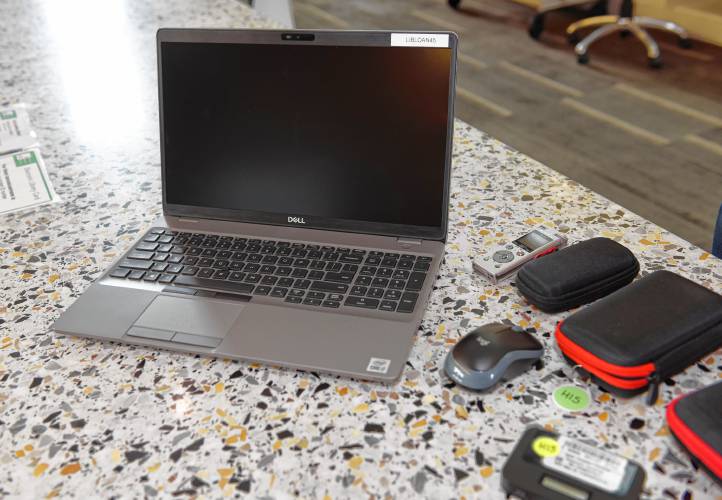Guest columnists Frank Robinson and Marvin Venay: Digital divide isn’t just about access

STAFF FILE PHOTO/PAUL FRANZ STAFF FILE PHOTO/PAUL FRANZ
| Published: 09-11-2023 6:51 PM |
Think about all the things we do online — remote work, completing school assignments, setting up appointments, keeping up with friends and loved ones, ordering food, clothing, and more. Now, imagine trying to do any of that without reliable access to the internet, without a computer, or without feeling that you can safely and efficiently use the internet.
That’s the reality still facing thousands of residents in communities throughout western Massachusetts — in Hampshire, Franklin, Berkshire and Hampden counties. While communities differ in their demographics, socioeconomic conditions, and infrastructure realities, each requires a holistic approach to advancing digital equity.
For years, conversations about digital access in these counties have been dominated by a focus on connectivity to the internet — the physical infrastructure. In his farewell address, former Gov. Charlie Baker touted his administration’s “last-mile” efforts to bring broadband infrastructure to communities in western Massachusetts, especially rural areas. Infrastructure improvements are a vital piece of the puzzle for dozens of communities and thousands of residents, but the full picture of the digital divide in this part of the state is far more complex.
In May 2021, the Alliance for Digital Equity, a coalition of organizations in western Massachusetts dedicated to better understanding and addressing the digital divide, released a report on the status of digital equity in Hampden, Hampshire, and Franklin counties. The report focused on three persistent drivers of digital inequity — lack of connectivity, lack of equipment, and lack of digital literacy — and helped quantify how significant these barriers are to folks, whether their community is rural, urban, or suburban.
Not surprisingly, the majority of residents in rural areas pointed to lack of connectivity as their greatest barrier to digital access, but so did 53% of people from low-income backgrounds, who are disproportionately represented in cities including Springfield, Holyoke and Chicopee. People without homes and members of BIPOC communities were most likely to point to lack of equipment as their primary barrier to access. And digital literacy was a significant challenge for older adults and for English language learners.
The scale of the challenge remains significant and, as the world moves more online, existing barriers threaten to not only perpetuate digital inequity, but also deepen racial, economic, health and education disparities by effectively denying access to critical resources and opportunities.
The data makes it clear: Broadband infrastructure alone isn’t enough, and a one-size-fits-all approach won’t meet the needs of far too many residents. To meaningfully shrink the digital divide in western Massachusetts, we need strategies that address all three “legs of the stool”: access to reliable, affordable internet, high-quality digital devices like computers and tablets, and culturally responsive skills training that meets people where they are and helps them gain the skills to navigate the digital world.
Collaborative, community-driven solutions are key to equitably and sustainably closing the digital divide. That’s why the Alliance for Digital Equity and Tech Goes Home, a nonprofit organization that has been working for more than two decades to address digital inequity are excited to be partnering with local, community-based organizations — beginning in Holyoke, Springfield and Chicopee — that address this critical issue.
Article continues after...
Yesterday's Most Read Articles
Together, they will offer tailored, 15-hour digital literacy courses, through which participants can gain not only knowledge and skills, but a digital device and a year of free, high-quality internet. The goal is to eventually provide similar opportunities throughout the three counties, for residents of urban, rural and suburban communities.
Partnering with organizations including Way Finders in Springfield, which works with residents to strengthen housing stability and economic mobility, the Alliance for Digital Equity and Tech Goes Home can put high-quality, proven digital equity programming and critical resources in the hands of local instructors who already have a deep understanding of the challenges and opportunities facing the communities they serve.
In response to the COVID-19 pandemic and as more and more of daily life moved online, both federal and state officials have devoted more resources to closing the digital divide. But we know from experience that top-down approaches that take a narrow view of digital equity, both causes and solutions, won’t get the job done. Working with and through local partners to identify approaches that meet community members where they are and address all three legs of the digital access stool is essential.
Making digital equity and opportunity a reality for every resident of western Massachusetts requires an intentional, holistic and collaborative approach. Together, the Alliance for Digital Equity, Tech Goes Home, and our partners will leverage more than $10 million in digital equity grant funding from the state to expand digital equity programming in western Massachusetts, and we are hopeful that our work together can serve as a model for how to sustainably open digital doors for all those who currently lack access.
Frank Robinson is the vice president of public health at Baystate Health and a founding member of the Alliance for Digital Equity. Marvin Venay is the chief advocacy officer at Tech Goes Home, a Massachusetts nonprofit focused on advancing digital equity across the state.

 Guest columnist Gene Stamell: We know what we know
Guest columnist Gene Stamell: We know what we know Michelle Caruso: Questions candidate’s judgment after 1980s police training incident
Michelle Caruso: Questions candidate’s judgment after 1980s police training incident Kathy Sylvester: Vote for expertise on May 6
Kathy Sylvester: Vote for expertise on May 6 Shirley and Mike Majewski: Vote for Blake Gilmore
Shirley and Mike Majewski: Vote for Blake Gilmore
